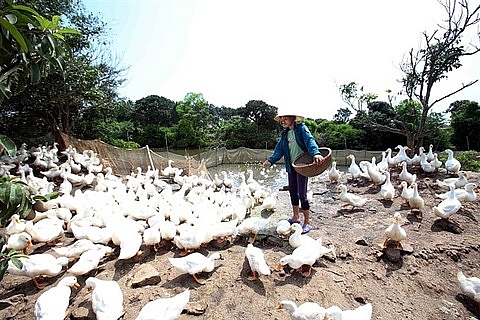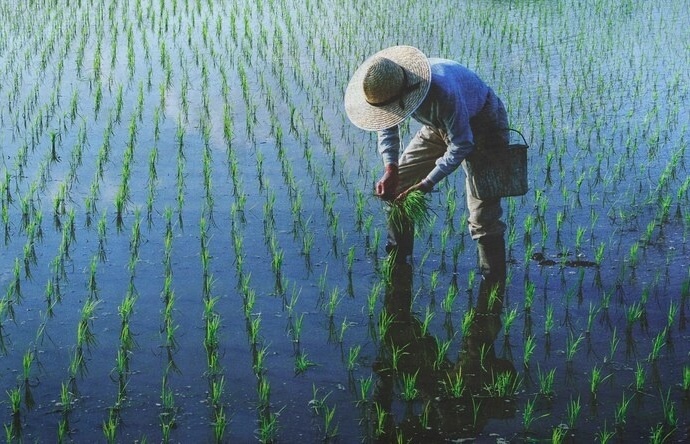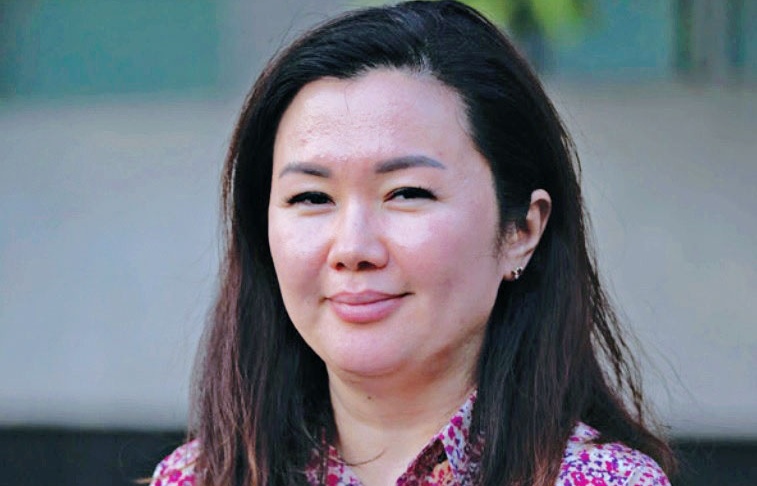VAT plan would hit household welfare: VEPR
 |
| Farmer Tran Thi He takes care of her flock of 2,000 ducks, worth VND120 million, in Phu Cu District in the northern province of Hung Yen. The MoF’s proposed VAT increase will have a negative impact on household welfare, according to a new study.-VNA/VNS Photo Pham Kien |
Thanh made the statement during a seminar held by VEPR on Thursday in Ha Noi, themed ‘Assessing the impacts of value-added tax increases on the overall economy and household welfare’.
Since 2017, the MoF had repeatedly proposed amendments to current tax laws towards increasing the number of tax rates, including raising the VAT under two separate scenarios.
Under the first scenario, VAT will be raised by 20 per cent, meaning that the commodities currently subject to 5 per cent and 10 per cent VAT, will be levied at 6 per cent and 12 per cent VAT, respectively.
The second scenario proposed is that commodities currently liable for a rate of 5 per cent VAT will be subject to a new VAT rate of 10 per cent. Meanwhile, commodities subjected to 0 per cent and 10 per cent VAT will experience no adjustment.
“VERP organised the seminar to announce a study which assessed the impacts of the MoF’s VAT increase proposal on household welfare, measured by the changes in the average expenditure of households and the rate of poor households after VAT is increased in each scenario,” Thanh said.
Nguyen Viet Cuong, a lecturer from the National Economics University and member of VEPR’s research team, said that with a fixed supply, raising VAT would increase the prices of the commodities.
With household budgets remaining unchanged, rising commodity prices would affect household consumption and welfare, Cuong said.
According to the Viet Nam Household Living Standard Survey (VHLSS) by the General Statistics Office in 2016, Viet Nam’s average annual expenditure per capita is over VND34.5 million, or an average monthly expenditure per capita of VND2.9 million.
VEPR’s research team said that the first scenario would have a stronger impact on households compared to the second.
Specifically, the first scenario would reduce household expenditure by 0.89 per cent, while the second scenario would reduce expenditure by 0.32 per cent.
The rate of poor households would increase by 0.26 percentage points if VAT is adjusted under the first option, and increase by 0.22 percentage points under the second option. The corresponding increase in the number of poor people in the two scenarios would be 240 people and 202 people, respectively.
However, according to the research team, the second option will also have negative effects on low-income households. Therefore, the government should carefully consider adjustments to VAT, as this is a trade-off between increasing the State budget and boosting economic growth as well as reducing poverty.
Fruitless
From a macro perspective, the study also showed that with the first scenario, state budget revenue will increase by 4.9 per cent. If the government spends the additional taxes on investment, total social investment will be by 1.7 per cent. However, total household income and expenditure will decrease by more than 0.9 per cent. Therefore, the real output of the economy would not increase.
Meanwhile, with the second plan, State budget revenue will increase by 2 per cent, lower than that in the first scenario. If the government uses this money on development investment, total social investment will rise by nearly 1.8 per cent.
“However, total household income and expenditures will reduce by 1 per cent. As a result, the output of the economy would not increase, too, similar to the first scenario,” Cuong said.
With these analyses, VEPR’s research team concluded that raising VAT does not increase the real output of the economy but leads to a reduction in household welfare.
“Therefore, this study does not agree with the proposed VAT increase,” Cuong said.
What the stars mean:
★ Poor ★ ★ Promising ★★★ Good ★★★★ Very good ★★★★★ Exceptional
Related Contents
Latest News
More News
- Coordination can ease logistics issues (November 03, 2024 | 20:05)
- Logistics infrastructure can enjoy a bright future (November 03, 2024 | 19:57)
- Connectivity a factor in positive results of logistics companies (November 03, 2024 | 19:37)
- Concerted efforts needed for sustainable aviation (November 03, 2024 | 17:10)
- Evaluation necessary to ensure business development (November 03, 2024 | 10:00)
- Robust fundamentals underpin growth outlook (October 31, 2024 | 17:20)
- Future trends and benefits in Vietnam’s logistics sector (October 29, 2024 | 14:00)
- A stronger digital economy ecosystem for Vietnam (October 29, 2024 | 10:11)
- Transit-oriented vision more than simply policy (October 24, 2024 | 18:00)
- Japanese groups accelerate their M&A activities in Vietnam (October 24, 2024 | 16:26)


 Tag:
Tag:




















 Mobile Version
Mobile Version